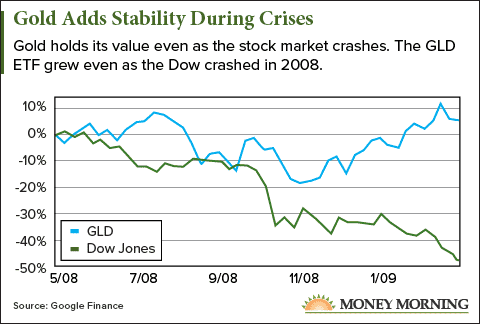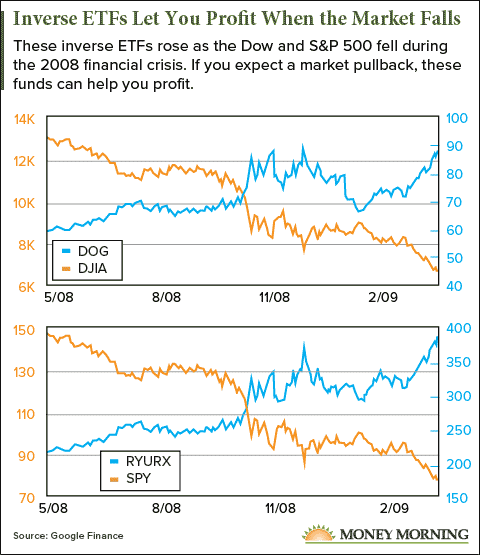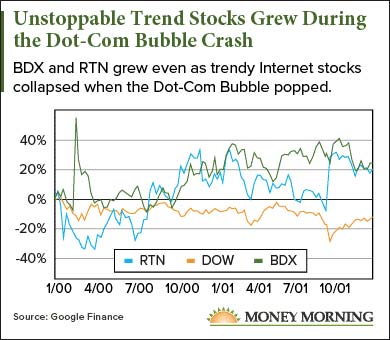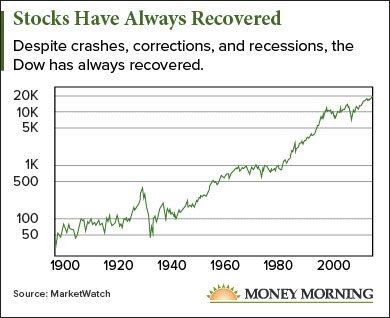Smart investors always have a plan to prepare for a stock market crash. In fact, stock market crashes only devastating because most investors are rarely prepared for a major pullback.
Plus, the timing of stock market crashes is impossible to predict with certainty...
 The stock market crash of 1929 wiped out 86% of the value of the Dow in just three years. But before the crash, the Dow had gained over 300% during the 1920s and economists were predicting that stocks could only rise. Famed economist Irving Fisher claimed stocks had reached a "permanently high plateau" in 1929, just over a month before the crash.
The stock market crash of 1929 wiped out 86% of the value of the Dow in just three years. But before the crash, the Dow had gained over 300% during the 1920s and economists were predicting that stocks could only rise. Famed economist Irving Fisher claimed stocks had reached a "permanently high plateau" in 1929, just over a month before the crash.
Investors were similarly caught off guard in 2000 and 2008. The dot-com bubble popped in 2000, leading to a 14% drop in the Dow in just over a month and a 36% decrease before it began recovering. The Dow lost half its value during the 2008 stock market crash.
If investors could've predicted the exact timing of these stock market crashes, then they wouldn't have been so painful. The 2008 collapse destroyed over $2 trillion worth of Americans' retirement savings.
While these losses are staggering, they aren't a reason to flee the stock market and keep your money hidden under the mattress. Avoiding the market out of fear is actually one of the biggest mistakes you can make.
At Money Morning, we believe you can control your financial future, and investing your money is the fastest route to financial independence. The Dow alone is up 228% since the recovery began in 2009, and investors who knew the right places to invest are up even more.
We also believe you can protect your money - and even profit - during a market crash...
Today, we're bringing you the strategies of four Money Morning experts to show you exactly where to put your money before the market crashes and what to do when the markets start falling.
We'll also show you how these tactics would have performed during past market crashes, so you can see exactly why they are so effective.
Urgent: Feds use obscure loophole to threaten retirees. If you have a 401(k), IRA, or any type of retirement account, this could cause you to miss out on $68,870 or more. Read more...
These strategies include knowing the essential stocks to own during a stock market crash, practicing a simple - and safe - way to profit as the market falls, using a time-tested strategy for stabilizing your portfolio during volatile swings, and learning how to use a market correction to your advantage...
Here's the Money Morning guide on how to how to survive a stock market crash...
How to Prepare for a Stock Market Crash, Step No. 1: Buy Gold
Owning gold is an excellent hedge against uncertainty in the stock market.
Money Morning Executive Editor Bill Patalon says gold is a "good 'store of value' when uncertainty gets out of hand."
"And we're definitely deep into what I refer to as the 'Era of Uncertainty,'" Bill said in March.
Gold's use as a hedge against stock market crashes is proven, too. Check out how gold held its value during the 2008 financial crisis below...

Between the start of the market crash in May 2008 and its end in March 2009, the Dow lost 49% of its value while gold prices actually rose over 5% in the same time.
Money Morning Chief Investment Strategist Keith Fitz-Gerald says while gold's stability is a real asset to any portfolio, you don't want to overdo it and put all your money in gold. Keith says studies have shown that putting 2% to 5% of your investable assets into gold adds stability to your portfolio without sacrificing growth.
There are three main ways of adding gold to your portfolio...
First, gold buyers can always purchase physical gold in the form of gold bars or coins. Investors just need to make sure they are buying from a legitimate dealer and have the ability to keep their gold secure.
Check out our complimentary guide on everything you need to know about buying gold and silver, right here...
How to Tell If Your Gold Is Real
For investors who would rather not deal with buying and selling gold through a dealer or auction house (and paying commission fees), there are more ways to invest in gold...
In the second method, investors can buy a gold exchange-traded fund (ETF). Gold ETFs mirror the value of gold and can be bought just like any other stock.
Keith recommends the SPDR Gold Trust ETF (NYSE Arca: GLD) for those looking for an ETF.
"I recommend the SPDR Gold Trust because it's easy to own, liquid, and well-established," said Keith.
A share in GLD isn't as expensive as an ounce of gold, but it gives investors the same benefits. For example, an ounce of gold currently sells for $1,249. That's an 8.7% increase over its price of $1,150 an ounce at the start of the year.
GLD currently trades at $120.10 a share and is up 9.5% on the year. As you can see, GLD comes very close to matching the change in value of physical gold.
Third, investors looking for more profit potential from gold can buy gold mining stocks.
Because gold miners' revenue will rise as gold prices go up, owning gold mining company stocks gives you exposure to the precious metal.
However, buying stock in a gold mining company is riskier than the other gold investing strategies because the stock could drop based on market events or poor business decisions. But investors with higher risk tolerance can seek out gold miners with profit potential.
Bill recommends the Canadian "mining heavyweight" Goldcorp Inc. (NYSE: GG) for investors investing in gold mining stocks.
"Goldcorp has consistently been one of the most innovative 'thinkers' in a business not often known for innovation," Bill said back in April.
More from Bill on Goldcorp
And Goldcorp is tapping into the power of the Watson artificial intelligence system, run by International Business Machines Corp. (NYSE: IBM). GG is using IBM's artificial intelligence system to help process geological data - including millions of core samples, seismic surveys, and theoretical modeling - to find the most lucrative areas to mine gold.
"I love this strategy," said Bill, "because of its innovativeness, and also because it has both near- and long-term focuses."
Shares of Goldcorp currently trade at $12.95, and analysts have one-year price targets up to $22 a share, a potential 70% gain.
Our second strategy won't just keep your money safe in the case of a stock market crash, but it will help you profit too...
How to Prepare for a Stock Market Crash, Step No. 2: Short the Broader Market
One of the simplest ways to profit during a market downturn is to short the overall market. While shorting a stock can expose investors to potentially unlimited losses, our strategy avoids the unnecessary risk so you can profit safely...
You see, a traditional short position requires the trader to sell borrowed stock and buy it back at a later date. If the stock's share price drops, then the trader makes a profit (they sold the borrowed stock at a high price, bought it back at a lower price, and pocketed the difference).
But this strategy can be risky if the stock's share price goes up.
While the lowest a stock can fall to is zero, there's theoretically no limit to how high it can climb. The biggest risk for a short seller is the stock's price rising, requiring them to repurchase the stock at a higher price than what they sold it for. There's no limit to how high their loss could be.
However, shorting the market doesn't have to be this risky.
Buying funds that short the overall market is a straightforward way to profit from a downturn without being susceptible to infinite risk. These funds are ones that go up when the stock market crashes.
Money Morning Capital Wave Strategist Shah Gilani recommends investors turn to the ProShares Short Dow30 ETF (NYSE Arca: DOG) if they are confident a downturn is on the way. DOG trades inversely to the Dow Jones Industrial Average, so when the Dow dives, DOG goes up.
Don't Miss: Shah's Zenith Trading Circle subscribers have had the opportunity to make average closeout gains of 83% (including partial plays) on his recommendations. His win record is insane (in a good way). Learn more...
Keith recommends a similar strategy, but instead of an ETF, Keith recommends the Rydex Inverse S&P 500 Strategy Fund (MUTF: RYURX), a mutual fund that trades inversely to the S&P 500.
As the stock market falls, the share prices of these funds will rise, and as the stock market climbs, the share prices of these funds fall. There's no need to take a risky short position on an individual stock to profit from a market downturn.
And as you can see, both DOG and RYURX brought their owners 48% and 72% returns respectively during the 2008 stock market crash...

Even though DOG and RYURX aren't as risky as traditional short positions, they do carry some risk. If the market rises, the value of these funds will fall. But investors can still protect themselves in two ways.
First, Keith says to use an inverse fund as a hedge.
Buying an inverse ETF or mutual fund is a short-term play, it's not a "set it and forget it" strategy like buying gold. Investors can buy in when they're confident the market is about to fall or that it will keep falling. But once the market recovers, it's time to sell these funds.
That also means not allocating more money to an inverse fund than you're willing to lose. For most folks, that will probably work out to less than 5% of your overall portfolio.
Using an inverse fund is simply a strategy to keep you profitable during a downturn or crash.
Second, Shah recommends putting "stops" on inverse ETFs like DOG.
This strategy means setting a percentage loss on DOG you're willing tolerate if the market keeps rising. A stop will automatically close your position once DOG hits your stop. Shah says he would use a 5% or 10% stop. Using a stop minimizes your losses while still giving you access to all the upside.
While our first two strategies are effective hedges against a market crash, you can still own stocks that will outperform the market in the rest of your portfolio...
How to Prepare for a Stock Market Crash, Step No. 3: Own In-Demand Stocks
A stock market crash starts when traders panic during "catastrophic events, an economic crisis, or the collapse of a long-term speculative bubble," according to Investopedia.
And a speculative bubble is exactly what led to the dot-com crash of 2000.
After the Internet was commercialized in 1995, investors poured money into Internet stocks, even if the actual business behind the stock was unprofitable. Investors were speculating Internet companies would change the economy.
There's no better example of this speculative betting than the rise of Pets.com, which held its IPO in 2000. The company raised $82 million during its IPO, but the Internet pet supply company was unprofitable. In 1999, the company only made $619,000, but it spent nearly $12 million on advertising.
This sort of risky speculation drove stock prices to unsustainable heights. The tech-heavy Nasdaq soared 571% between 1995 and its pre-crash peak on March 10, 2000.
When the tech bubble popped, the whole market fell. Pets.com stock collapsed from $14 a share to $0.22 a share by the end of 2000. Between March 2000 and the end of the crash in October 2002, the Nasdaq plummeted 77% as tech stocks plunged. And the tech stock crash dragged down the broader market too, as the Dow fell 36% in the same time period.
But investors who didn't chase speculative positions and stuck to companies in the most in-demand sectors were protected from the worst of the crash. Some investors even profited during the tech stock crash of 2000.
The trick to making huge profits is to find "must-have" companies that fall into what Keith Fitz-Gerald calls the six "Unstoppable Trends": medicine, technology, demographics, scarcity & allocation, energy, and war, terrorism & ugliness (known collectively as defense). The Unstoppable Trends are backed by trillions of dollars that Washington cannot derail, the Fed cannot meddle with, and Wall Street cannot hijack.
Two of Keith's favorite Unstoppable Trend stocks are Raytheon Co. (NYSE: RTN) and Becton, Dickinson and Co. (NYSE: BDX). RTN and BDX are leaders in the Unstoppable Trends of defense and demographics, respectively.
Raytheon is one of the leading defense contractors in the United States, with the third-largest contract portfolio of all defense contractors. Because defense is an ever-present need, Raytheon's services will always be in demand.
Similarly, BDX provides medical supplies for hospitals and long-term care facilities. And because populations are always aging, Becton Dickinson's products are always in demand.
Check out how some of Keith's favorite Unstoppable Trend stocks fared during the dot-com crash in 2000 in the chart on the right.
 If you owned these companies during the dot-com bubble, you would have profited over 20%, even as the Dow fell 12% between 2000 and 2002.
If you owned these companies during the dot-com bubble, you would have profited over 20%, even as the Dow fell 12% between 2000 and 2002.
And RTN and BDX are still going strong.
Raytheon is up 19% on the year, while Becton Dickinson is up 22%. Both are doubling the
Dow's 9.7% gain on the year. Plus, Wall Street analysts are bullish on both companies going forward.
Raytheon has one-year price targets as high as $192 a share, a 14% gain from today's price of $169 a share. BDX is forecasted to grow up to $230 a share in a year, also a 14% jump from today's $202 share price.
On top of the forecasted growth for both companies, because they are consistently profitable and well-managed, they each pay a healthy dividend. Raytheon pays out $0.80 a share for a 1.89% yield, and Becton Dickinson pays out $0.73 a share for a 1.44% yield. That's added income for investors that can help pad a portfolio during a volatile market.
While these first three steps will help protect your portfolio from a stock market crash, our fourth step shows you how to turn a market crash into an opportunity to book explosive profits...
[mmpazkzone name="in-story" network="9794" site="307044" id="137008" type="4"]
How to Prepare for a Stock Market Crash, Step No. 4: Buy Tech at a Discount
Money Morning Technical Trading Specialist D.R. Barton, Jr., says a market downturn is a great time to buy some of the best stocks at a discount.
Barton says investors who buy "any or all of the 'Fab Five' tech stocks" on a downturn will be glad they did. The "Fab Five" include Facebook Inc. (Nasdaq: FB), Amazon.com Inc. (Nasdaq: AMZN), Microsoft Corp. (Nasdaq: MSFT), Alphabet Inc. (Nasdaq: GOOGL), and Apple Inc. (Nasdaq: AAPL).
These stocks are up an average of 31% this year, more the triple the Dow's 9.4% gain so far. If the market dipped, you would have the opportunity to buy into the most innovative tech companies in the world at a discounted share price.
And here's why this makes sense...
Throughout the Dow's history there have been crashes, corrections, and pullbacks - there have been four pullbacks of at least 10% during the current eight-year bull market alone. But the market has consistently rallied back to new highs.
You can see how the Dow has fallen and recovered throughout its history below.
 To show how effective this strategy would have been during the 2008 stock market crash, let's look at how investors who owned the Fab Five tech stocks would have done, depending on when they bought in or added to their positions.
To show how effective this strategy would have been during the 2008 stock market crash, let's look at how investors who owned the Fab Five tech stocks would have done, depending on when they bought in or added to their positions.
Investors who bought an equal share of the Fab Five tech stocks before the 2008 crash - the market peaked in 2008 on May 9 - would be up 490%. While that's a great return, because these are some of the best stocks you can own, investors who bought during the crash would have done even better. Investors who bought the Fab Five stocks at the trough of the crash - March 6, 2009 - would be up an average of 753% by now.
Up Next: Ten Triple-Digit Winners This Year, and Counting
Keith Fitz-Gerald's Money Map Report subscribers who have followed along with his recommendations are now sitting on 10 triple-digit winners this year - including a 201.68% return and 132.35% gain that closed out in the same week.
Each week, Keith shows everyday Americans how to tap into the world's biggest high-profit trends, ahead of the crowd.
There's nothing complicated or overly risky - and no guesswork involved.
Right now he's looking at another double-your-money opportunity, and there's still time to get in on it. Find out how to subscribe and access all of Keith's recommendations by clicking here now.
Follow Money Morning on Twitter @moneymorning, Facebook, and LinkedIn.


